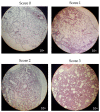Evaluation of a Recombinant Mouse X Pig Chimeric Anti-Porcine DEC205 Antibody Fused with Structural and Nonstructural Peptides of PRRS Virus
- PMID: 31126125
- PMCID: PMC6631554
- DOI: 10.3390/vaccines7020043
Evaluation of a Recombinant Mouse X Pig Chimeric Anti-Porcine DEC205 Antibody Fused with Structural and Nonstructural Peptides of PRRS Virus
Abstract
Activation of the immune system using antigen targeting to the dendritic cell receptor DEC205 presents great potential in the field of vaccination. The objective of this work was to evaluate the immunogenicity and protectiveness of a recombinant mouse x pig chimeric antibody fused with peptides of structural and nonstructural proteins of porcine respiratory and reproductive syndrome virus (PRRSV) directed to DEC205+ cells. Priming and booster immunizations were performed three weeks apart and administered intradermally in the neck area. All pigs were challenged with PRRSV two weeks after the booster immunization. Immunogenicity was evaluated by assessing the presence of antibodies anti-PRRSV, the response of IFN-γ-producing CD4+ cells, and the proliferation of cells. Protection was determined by assessing the viral load in the blood, lungs, and tonsils using qRT-PCR. The results showed that the vaccine exhibited immunogenicity but conferred limited protection. The vaccine group had a lower viral load in the tonsils and a significantly higher production of antibodies anti-PRRSV than the control group (p < 0.05); the vaccine group also produced more CD4+IFN-γ+ cells in response to peptides from the M and Nsp2 proteins. In conclusion, this antigenized recombinant mouse x pig chimeric antibody had immunogenic properties that could be enhanced to improve the level of protection and vaccine efficiency.
Keywords: DEC205; PRRSV; antigen targeting; chimeric antibody; dendritic cells; recombinant antibodies.
Conflict of interest statement
The authors declare that they have no conflicts of interest. The funders had no role in the design of the study; in the collection, analysis, or interpretation of the data; in the writing of the manuscript; or in the decision to publish the results.
Figures







Similar articles
-
Dendritic cell-targeted porcine reproductive and respiratory syndrome virus (PRRSV) antigens adjuvanted with polyinosinic-polycytidylic acid (poly (I:C)) induced non-protective immune responses against heterologous type 2 PRRSV challenge in pigs.Vet Immunol Immunopathol. 2017 Aug;190:18-25. doi: 10.1016/j.vetimm.2017.07.003. Epub 2017 Jul 10. Vet Immunol Immunopathol. 2017. PMID: 28778318
-
Recombinant Porcine Reproductive and Respiratory Syndrome Virus Expressing Membrane-Bound Interleukin-15 as an Immunomodulatory Adjuvant Enhances NK and γδ T Cell Responses and Confers Heterologous Protection.J Virol. 2018 Jun 13;92(13):e00007-18. doi: 10.1128/JVI.00007-18. Print 2018 Jul 1. J Virol. 2018. PMID: 29643245 Free PMC article.
-
Production of a full chimeric mouse x pig anti-porcine DEC205 receptor recombinant antibody.J Immunol Methods. 2021 Feb;489:112911. doi: 10.1016/j.jim.2020.112911. Epub 2020 Nov 10. J Immunol Methods. 2021. PMID: 33186587
-
Lymphocyte activation as cytokine gene expression and secretion is related to the porcine reproductive and respiratory syndrome virus (PRRSV) isolate after in vitro homologous and heterologous recall of peripheral blood mononuclear cells (PBMC) from pigs vaccinated and exposed to natural infection.Vet Immunol Immunopathol. 2013 Feb 15;151(3-4):193-206. doi: 10.1016/j.vetimm.2012.11.006. Epub 2012 Nov 19. Vet Immunol Immunopathol. 2013. PMID: 23228653
-
Live porcine reproductive and respiratory syndrome virus vaccines: Current status and future direction.Vaccine. 2015 Aug 7;33(33):4069-80. doi: 10.1016/j.vaccine.2015.06.092. Epub 2015 Jul 4. Vaccine. 2015. PMID: 26148878 Review.
Cited by
-
Antigen Targeting of Porcine Skin DEC205+ Dendritic Cells.Vaccines (Basel). 2022 Apr 26;10(5):684. doi: 10.3390/vaccines10050684. Vaccines (Basel). 2022. PMID: 35632440 Free PMC article.
-
Swine Dendritic Cell Response to Porcine Reproductive and Respiratory Syndrome Virus: An Update.Front Immunol. 2021 Jul 28;12:712109. doi: 10.3389/fimmu.2021.712109. eCollection 2021. Front Immunol. 2021. PMID: 34394113 Free PMC article. Review.
-
Recent advances in antigen targeting to antigen-presenting cells in veterinary medicine.Front Immunol. 2023 Mar 10;14:1080238. doi: 10.3389/fimmu.2023.1080238. eCollection 2023. Front Immunol. 2023. PMID: 36969203 Free PMC article. Review.
-
Skin-Based Vaccination: A Systematic Mapping Review of the Types of Vaccines and Methods Used and Immunity and Protection Elicited in Pigs.Vaccines (Basel). 2023 Feb 16;11(2):450. doi: 10.3390/vaccines11020450. Vaccines (Basel). 2023. PMID: 36851328 Free PMC article. Review.
References
-
- Bonifaz L.C., Bonnyay D.P., Charalambous A., Darguste D.I., Fujii S.-I., Soares H., Brimnes M.K., Moltedo B., Moran T.M., Steinman R.M. In vivo targeting of antigens to maturing dendritic cells via the DEC-205 receptor improves T cell vaccination. J. Exp. Med. 2004;199:815–824. doi: 10.1084/jem.20032220. - DOI - PMC - PubMed
-
- Coconi-Linares N., Ortega-Dávila E., López-González M., García-Machorro J., García-Cordero J., Steinman R.M., Cedillo-Barrón L., Gómez-Lim M.A. Targeting of envelope domain III protein of DENV type 2 to DEC-205 receptor elicits neutralizing antibodies in mice. Vaccine. 2013;31:2366–2371. doi: 10.1016/j.vaccine.2013.03.009. - DOI - PubMed
-
- Birkholz K., Schwenkert M., Kellner C., Gross S., Fey G., Schuler-Thurner B., Schuler G., Schaft N., Dörrie J. Targeting of DEC-205 on human dendritic cells results in efficient MHC class II-restricted antigen presentation. Blood. 2010;116:2277–2285. doi: 10.1182/blood-2010-02-268425. - DOI - PubMed
Grants and funding
LinkOut - more resources
Full Text Sources
Other Literature Sources
Research Materials

